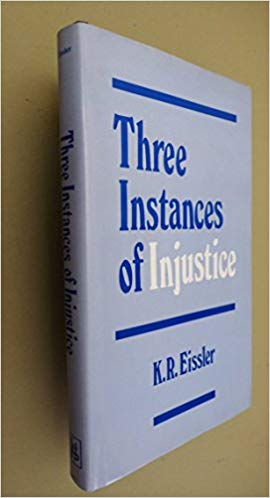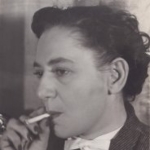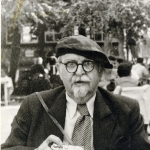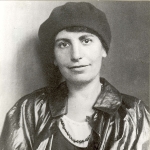Background
Kurt Robert Eissler was born on the 2nd of July, 1908 in Vienna, Austria.

1937
Universitätsring 1, 1010 Wien, Austria
Kurt Eissler attended the University of Vienna, where he received a Doctor of Philosophy degree in Psychology in 1931 and a Doctor of Medicine in 1937.

(An important new work by Eissler, Three Instances of Inju...)
An important new work by Eissler, Three Instances of Injustice develops a psychoanalytic point of view about the phenomenon of gossip, provides a careful disproof of one of the ugliest charges laid against Freud, and presents a thoughtful exploration of a major scandal.
https://www.amazon.com/-/es/gp/product/0823665305/ref=dbs_a_def_rwt_hsch_vapi_taft_p1_i3
1993
Kurt Robert Eissler was born on the 2nd of July, 1908 in Vienna, Austria.
Kurt Eissler attended the University of Vienna, where he received a Doctor of Philosophy degree in Psychology in 1931 and a Doctor of Medicine in 1937. In 1938, he earned a diploma from the American Board of Psychiatry. His doctoral thesis under Professor Karl Bühler was on the constancy of visual configurations in the variations of objects and their representation.
Eissler trained in psychoanalysis at the Vienna Psychoanalytic Institute and became assistant to August Aichhorn in his residential center for juvenile delinquents in 1938. Shortly thereafter, he fled the Nazi occupation and emigrated to the United States, settling first in Chicago, where he achieved certification in psychiatry from the American Board of Psychiatry and Neurology.
During the Second World War, in 1943, Kurt Eissler became a captain in the US Army Medical Corps, specializing in neuro-psychiatry until 1946. He moved to New York when the war ended, and established a psychoanalytic practice. He joined the New York Psychoanalytic Society and Institute, where he became a Training and Supervising Analyst and a valued member of the faculty.
In 1952, with other colleagues, Robert Eissler founded the Sigmund Freud Archives, deposited in the Library of Congress, Washington, D.C., and it was as its tireless secretary that he collected so many invaluable documents about, by, or related to Freud and his associates. He established the Anna Freud Foundation in the United States, also in 1952, thus facilitating tax-free donations for the benefit of the Hampstead Child Therapy Course in London, and the associated clinic she had just set up. He strongly supported the work of what quickly became the world's leading center for child analytic training and for child analytic research.
Kurt Eissler wrote about a hundred papers and a dozen books, dealing with the most varied topics, problems of psychoanalytic technique, treatment of psychotics, delinquency, art, psychoanalytic interpretation of history, etc. His first major psychoanalytic publication in the United States was the book he edited in honor of Aichhorn, his former mentor, Searchlights on Delinquency in 1949. This was followed by a steady outpouring of papers and books, many of which have become classics in the field. They include his landmark volume on The Psychiatrist and the Dying Patient in 1955, a major study of Leonardo da Vinci in 1961, and two-volume psychoanalytic biography of Goethe in 1963.
(An important new work by Eissler, Three Instances of Inju...)
1993Kurt Robert Eissler was pessimistic about the future of psychoanalysis and, indeed, civilization. He was no idolater of Freud or Anna Freud but defended the basic principles without which, he felt, psychoanalysis would cease to be psychoanalysis.
Kurt Eissler was immensely learned, and a captivating and engaging speaker whose somewhat wry but engaging sense of humor augmented the liveliness with which he enriched the discussion. His interests were wide-ranging. His personality made him a fascinating person, apparently shy at times reserved in public, Kurt was able to open up with few people showing extraordinary warmth and a strong sense of humor. Not infrequently he was quite ironical and unpredictable.
Quotes from others about the person
"His irreverence - his own word - for rigid orthodoxies defined his consistent stance as a classical psychoanalyst impatient with institutional inflexibilities, which he believed endangered the future of psychoanalysis". - J. Stone.
Kurt Eissler was married to Ruth Selke.

Ruth Selke Eissler was born on the 21st of February, 1906, in Odessa and died on the 7th of October, 1989, in New York. She was a physician and a psychoanalyst. She was a member and training analyst of the Chicago Psychoanalytic Society and worked as a child psychiatrist at the Michael Reese Hospital. During the Second World War, she was a consulting physician in an institution for young delinquent women in Chicago. From 1951 to 1957 she was secretary, then vice president of the International Psychoanalytic Association and, from 1950 to 1958, one of the editors of The Psychoanalytic Study of the Child, an annual publication founded in 1945 by Anna Freud, Heinz Hartmann, and Ernst Kris. Aside from her teaching activities and psychoanalytic publications, she wrote poetry and a novel, as well as several short stories.

August Aichhorn was born on the 27th of July, 1878 in Vienna and died on the 13th of October 13, 1949 in Vienna. He was an Austrian educator with an interest in psychoanalysis, the pioneer of a new approach to reeducating problem children. He became a teacher and continued his studies at the Technische Hochschule of Vienna.
From 1908 to 1918 he was in charge of managing homes for boys in the Austrian capital. In 1918 he was made responsible for setting up an educational center for delinquent children in an unused refugee camp. Convinced that the suppression then commonly practiced was not the right approach, and disappointed by the kinds of psychological training taught at the university, he introduced unorthodox methods, based on warm sympathy with the fate of those unfortunates and was correctly guided by an intuitive perception of their mental needs. His educational success caught the attention of Anna Freud, and it is through her that he discovered psychoanalysis when he was already past forty. He undertook an analysis with Paul Federn and, in 1922, became a member of the Vienna Psychoanalytic Association. When his experiment in reeducation came to an end, Aichhorn created, in 1923, educational centers that focused on psychoanalysis in each of Vienna's fourteen districts. He worked in the centers, always at his teacher's salary, until his retirement in 1930.

